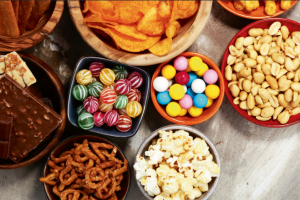Savoury snack showcase

Some 155 exhibitors descended on Vienna, Austria, for the biennial Snackex trade show and conference from 21-22 June. Katie Smith reports.
Snackex provided the perfect opportunity to find out more about new developments and trends within the savoury snacks industry. Conference presentations highlighted how the concept of snacking is developing, while exhibitors presented novel solutions to help manufacturers meet these trends.
How consumers snack is changing, according to market research company Mintel, and manufacturers have to be flexible to meet these trends. “Snacking has become more than just an in-between snack,” explained Marcia Mogelonsky, director of insight for food and drink at Mintel.
As more and more consumers are replacing meals with snacks, she added that “there are lots of opportunities for when to snack.”
Making snacks stand out is important and can be improved by tapping into flavour innovations, convenience, portability, health and permissible indulgence trends. Although packaging is key to helping drive purchases, flavour also drives purchases, for example, watermelon seeds flavoured with mild chilli are now available in the UK.
Consumers are constantly rationalising with themselves to have healthier, portion controlled snacks, she said. This is being reflected with ‘better for you’ packaging and ‘thin’ product launches, which implies the item is better for consumers.
Pinar Hosafci, senior food analyst at Euromonitor International, focused on the state of the European savoury snacks industry in 2017 and the rise of alternative snacks. She highlighted new research by Euromonitor which found that consumers around the world are now switching to savoury snacks – triumphing total snacks growth for the fifth year in a row.
Addressing the audience, Hosafci said, it’s true for many consumers that eating habits have changed “drastically,” adding that “over the last few years savoury snacks have consistently outperformed the rest of foods, particularly staple foods such as baked goods and vegetables.”
With the exception of Eastern Europe, savoury snacks share has grown across all regions while that of confectionery has fallen. What is the reason for this? According to Hosafci, sugar is the obvious culprit.
“The move towards savoury snacks is motivated by what has been dubbed as the ‘backlash against sugar’, she explained. “Sugar is becoming increasingly vilified by media and some retailers have even pledged to take sugar out of own label products.
“Similarly, governments are also taking action to reduce consumers’ daily sugar intake. Mexico has put on a calorie tax on fatty and sugary food exceeding 250 calories per pack and a 10 per cent surcharge on sugary drinks and countries including Australia, Colombia, India, Indonesia, the Philippines and the UK are discussing a similar sugar tax. This is rightly so, especially in developed markets like Europe, where the sugar purchase is very high. In the UK and Germany, 73g of sugar is being bought on average per capita per day. Daily recommended intake is 50 for an adult, recommended from WHO is 25g.” Globally, 30 per cent of all snack sales in 2017 come from savoury snacks; in North America that share reaches 40 per cent. Salty snacks account for over half of savoury snack sales. Of the top five savoury snack markets, only in Brazil are savoury biscuits more popular than salty snacks.
Within salty snacks, potato chips lead sales thanks to their established presence in the US and the UK, and a growing share in China, where they overtook rice snacks in 2014. Another category to watch out for is nuts, seeds and trail mixes, which has overtaken tortilla chips in the US for the first time in 2017.
So where to next? “Protein is something to pay attention to,” Hosafci said, adding that products coming to market include protein milk, bars, soup and yogurt. In addition, algae is “quite promising” as an ingredient because it meets nutirition, health and wellness, sustainability and all natural trends. Examples include spirulina flavoured protein balls and chlorella-based snacks. What’s more is that insects are also on the rise, with Hosafci revealing that some companies are experimenting with insect and worm based protein substitutes.
Research by taste and nutrition group Kerry supports the growing popularity in novel snacks, which found that 41 per cent of millennials think healthier snacks are generally poorer in taste, while 28 per cent are willing to pay more for novel snacks, both statistics providing plenty of scope and direction for future product development.
Product showcases
The main focus for enterprise software solutions provider Aptean at the show was its Factory MES solution, which is part of the overall Aptean F&B solution suite. “Factory MES is designed specifically for food and beverage manufacturers and is used to empower their shop floor teams with real time visibility into production and quality operations, supporting the transition to a culture of action and a paperless shop floor,” explained James Wood, director for the Factory MES product line.
The company also showcased its new wireless automation solution, designed to accelerate deployment and provide a low cost, low disruption data collection component that feeds Factory MES. “The interest we had was better than expected and the show was a great success for us,” Wood added.
Meanwhile, Dutch starch manufacturer Avebe highlighted its potato protein solutions, including its Solanic potato proteins. They are 100 per cent plant based, non-GMO and free from allergen labelling. Jaap Harkema, marketing manager for Solanic proteins at Avebe, emphasised how demand for high protein products is increasing. Consumers want guilt free snacking, he noted, but the challenge is to maintain the right taste and texture.
Constantia Flexibles used the show to highlight its duplex laminates for salted snacks and triplex laminates for nuts and seeds, as well as duplex lid films. The company focused on easy opening functionalities, which is particularly important for snacks that are consumed on the go with no opening devices available. One of its highlights was its ReLap solution. Due to the combination of different technologies such as lasers, partial laminating, as well as the application of coatings, ReLap enables novel composite structures. By peeling away a strip of material a sticky surface is revealed, enabling multi reclose. Another showcase was its CompresSeal packaging solution, which is said to be environmentally friendly – lower material consumption PE but with the same properties – and displays increased productivity because of higher speed on pack line.
Food processing equipment supplier Baker Perkins showcased a new generation of extrusion equipment for the snacks industry. The SBX Master twin-screw extruder range for snacks has been redesigned and a new preconditioner added to the range to increase flexibility. The SBX Master extruder has been improved by increasing power, torque and speed. This, along with a range of barrel lengths, increases the variety of end products that can be made while barrel diameters between 50mm and 125mm give an output range from 500 to 2,300kg per hour. The company also highlighted its MPF24 small batch extruder for development work and low production runs.
Flo-Mech showcased its Flo-Flavour on demand flavour mixing and application system. Flo-Flavour consists of a powder feeder and oil flowmeter a small mixing tank with agitator and a peristaltic pump. With a LEAN engineering design, the system uses the latest technology in mixing together powder flavourings and oil while keeping the components in homogenous suspension before delivery to the seasoning drum via an application lance. It is designed to reduce unit footprint size as well as batch size and potential flavouring waste. Seasoning powder is added into the powder hopper by the operator. The powder and oil ratio is added continuously into the mixing tank at the recipe rate. The Flo-Flavour works in conjunction with the seasoning drum infeed weigh vibrator to accurately apply the correct amount of slurry as determined by the recipe to the product within the seasoning drum via the peristaltic pump.
Heat and Control presented what it describes as the next generation of FastBack solutions to meet industry sanitation requirements. This included the FastBack 260E G3, Revolution Gate 3.0 and Cartridge open channel support system. Key design features such as IP65 cabinets with flush doors assist cleaning in both wet and dry applications. Threadless feet, open channel support structures (no closed tubes), sloped tops and easy access drawer control panels also contribute to sanitation and ease of use.
Ishida highlighted Inspira, the company’s next generation range of vertical form, fill and seal (VFFS) bagmakers, with models of both types of sealing technology. The chassis on which Inspira machines are built is a new, open structure that makes access to important parts of the bagmaker quick and easy with minimum operator effort, according to the company. Its stable, frame-based design makes it possible to simplify operations which, in a less rigid structure, would typically require fine adjustments. The human machine interface (HMI) has also been redesigned to make operations simpler and to enhance operator productivity.
Polar Systems presented its new gas popcorn kettle, which is said to have several benefits, including a remote package burner that removes the flame form the cooking area and an insulated outer layer to reduce cracking in the kettle sides. The company’s new metered screw feeder benefits from quick and tool free disassembly for cleaning a product changeover – less than 15 seconds – as well as improved accuracy as standard when compared to others on the market. Also on show was a flavour additions tumbler drum and liquid/oil/slurry additions system.
Tomra focused on its sorting solution for nuts and raisin processors, Nimbus BSI. With a combination of various sorting technologies, the Nimbus free fall sorting machine with Biometric Signature Identification (BSI) meets the high requirements of the food industry and individual processors for safe and excellent food quality by removing unwanted material. The machine includes a Smart Sort module to assist operators, improving the contrast between good and defect product, and is easy to set and operate; one program fits all nuts and raisin varieties.
UVA Packaging used the show to focus on its specialty bags, including tear and share which has a resealable closing. The company’s Lima-C Series of continuous motion packaging machine is designed to make packaging stand out on shelf. With a stainless steel frame, the machine has a colour touch screen for production information and fault display. As well as doy and push pop styles, the machine is able to produce up to 200 pillow bags per minute and up to 140 block bottom bags per minute.
The next Snackex will take place in Barcelona, Spain, from 27-28 June 2019.



